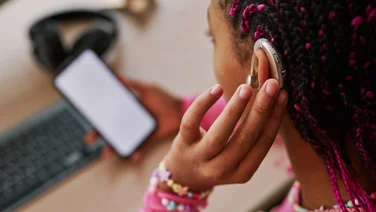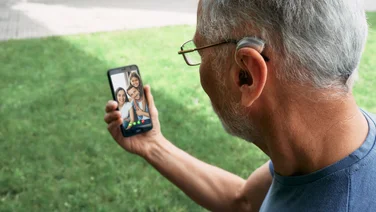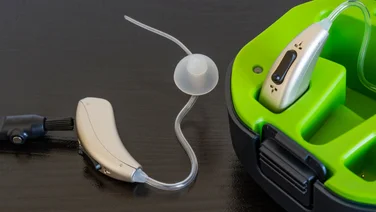To help us provide you with free impartial advice, we may earn a commission if you buy through links on our site. Learn more

Making phone calls, watching TV, or listening to music hasn’t always been easy for the wearers of most types of hearing aids. Multiple layers of electronically-enhanced background noise can even make these activities harder than they would be wearing no hearing aids at all. However, Bluetooth hearing aids claim to be able to make this problem a thing of the past.
Bluetooth hearing aids work by streaming enhanced sound directly from a chosen device, while simultaneously dampening ambient noise. As well as working like a cross between conventional digital hearing aids and Bluetooth headphones, Bluetooth hearing aids can be controlled via an app that turns your phone into a fully-featured remote.
Bluetooth is no longer an expensive extra. You don’t get it in all hearing aids, especially the very smallest ‘invisible’ models, but it tends to be a standard feature these days – certainly, nearly all of the hearing aids in Specsavers’ range have Bluetooth.
Read on for a closer look at how Bluetooth works to improve many wearers’ experience of hearing aids, and how it can re-connect them with their other home devices.
Looking to find out how much hearing aids could cost?
Take our quick survey below and we’ll match you with a specialist that suits your needs.
How do Bluetooth hearing aids work?
Bluetooth is a short-range wireless technology that allows two devices to communicate across several metres. Some makers claim a top range of up to 30m, although in our experience the maximum is about half that, as walls and windows have a habit of getting in the way.
Most Bluetooth hearing aids work as direct streamers, delivering audio directly to your aids from your phone or other Bluetooth-enabled devices, such as smart speakers, TVs, computers and car stereos. You select the audio you want to hear and your hearing aids deliver an enhanced, clarified version of it directly to your ears, subject to your own personalised settings and level of hearing loss.To help combat background noise – which many wearers of hearing aids find unbearably intrusive when they’re trying to have a conversation or focus on a particular sound – most Bluetooth hearing aids automatically switch off their microphones when streaming. When you switch the mic back on, potentially by using the connected app on your phone, the hearing aids return to working just like conventional hearing aids, enhancing and amplifying the sound around you.
Some older Bluetooth hearing aids require an additional device called a streamer, which converts Bluetooth signals into FM signals that deliver enhanced sound from whatever the audio source may be. However, most new models don’t need this and are designed to work directly with Android phones, iPhones, and other Bluetooth devices. That said, if you want your hearing aid to stream directly from a particular type of phone, it’s worth mentioning it to your audiologist when discussing your options, just to be sure.
READ NEXT: How do hearing aids work?
Do all digital hearing aids have Bluetooth?
Most do. In fact, it’s pretty unusual to find new behind-the-ear (BTE) and in-the-ear (ITE) hearing aids that don’t include Bluetooth, and now it’s even included in some smaller in-the-canal (ITC) hearing aids as well.
These days the only hearing aids that don’t have Bluetooth tend to be some of the very smallest ‘invisible’ hearing aids – which you’ll variously see labelled as either completely-in-canal (CIC) or invisible-in-canal (IIC) – and this is because they’re often simply too small to accommodate a Bluetooth chip.
However, hearing aid manufacturers know that small size and Bluetooth are two of the most highly demanded features for hearing aids, so they’re working on getting Bluetooth into the smallest possible package. The CIC version of the custom-moulded Starkey Genesis AI – which will be available in the UK from November 2023 – comes with enhanced streaming and is one of the smallest Bluetooth hearing aids you can buy, but this smart sound-enhancing aid is likely to cost well over £3,000 per pair at launch.
Want to find out how much hearing aids could cost?
Why should I buy Bluetooth hearing aids?
The main benefit of Bluetooth hearing aids, as mentioned, is their ability to stream sound directly and wirelessly from your chosen sound source, with little or no ambient noise getting in the way.
You can pair your hearing aids with multiple compatible devices – including your TV, car stereo, smart speaker, and computer, as well as your phone – and it will then connect automatically when you have both devices switched on and Bluetooth mode enabled. This setup frees you to connect to whichever sound source you choose and focus on it fully.
Better sound quality. As well as reducing background noise and ambient sound, Bluetooth hearing aids are said by many wearers to deliver sharper, cleaner sound.
Better localisation. A pair of Bluetooth hearing aids work in sync using binaural hearing technology, so they mimic the natural localisation of both ears. Hearing aids without Bluetooth usually process sound separately, which can sometimes make it hard to work out where a sound is coming from.
Your hearing aids become headphones. Wearing headphones at the same time as hearing aids can be uncomfortable and deliver below-par sound quality. Bluetooth completely does away with the need for separate headphones by linking directly to the sound source. As with Bluetooth headphones, your Bluetooth hearing aid is also handy for remotely controlling the device’s volume.

Better (and more discreet) control. Most Bluetooth hearing aids come with a fully-featured smartphone app that allows you to quickly, easily, and discreetly adjust the volume – and other settings – from your phone rather than by touching your hearing aids.
Custom settings. Personalised settings aren’t limited to Bluetooth hearing aids, but these aids do tend to offer a greater-than-average range of custom options via their connected phone app. You can fine-tune the volume, check the battery usage, choose preset noise environments and so on, all from the app.READ NEXT: Why are hearing aids so expensive?
What are the downsides of Bluetooth hearing aids?
Historically, the two biggest disadvantages of Bluetooth hearing aids have been their extra expense and their lack of availability in small sizes. But nowadays, this is less and less the case – even the affordable Specsavers Advance range features a CIC model with Bluetooth connectivity.
However, Bluetooth does drain your battery relatively quickly when you’re connected and streaming. So if you’re already a high-drain user, Bluetooth will only add to the reasons why your hearing aids lose power faster than you’d like. Rechargeable hearing aids will prove more convenient than non-rechargeable ones, particularly if you’re a high-drain Bluetooth hearing aid user.
If you do choose to use disposable batteries, then look for long-life batteries that won’t fail you when you’re halfway through your favourite programme. Check out our article on the best hearing aid batteries to help you choose.






